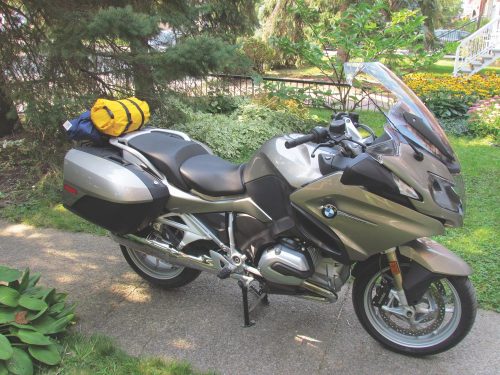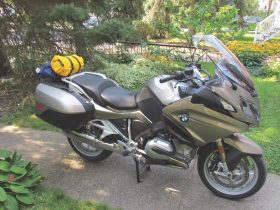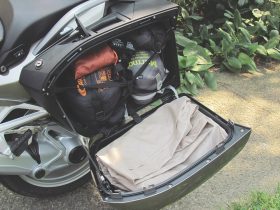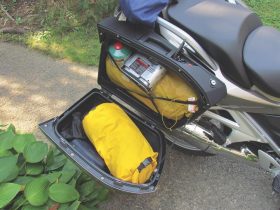Modern equipment makes life on the road easier.
Motorcycles and camping go hand in hand. At least to me they do. I’ve been loading up my motorcycles for camping trips for about three decades. My first camping trips included loading up a bike with equipment so high I felt compelled to pay attention to the clearance signs posted on overpasses. Not only did such packing look unsightly, it also posed hazards, as it was unstable, and added a lot of weight high and rearward, which didn’t have a beneficial effect on the bike’s centre of gravity. Fortunately, camping gear has come a long way since then; it has become lighter and more efficient, and it packs much smaller.
 There are compromises that must be made when taking a camping trip on a bike versus in a car due to the former’s lack of storage space, but by shopping around for the right equipment, you can enjoy most of the camping convenience of travelling on four wheels. Be advised, though, that for the ultimate in lightweight camping gear, you’ll have to dig deep into your pockets.
There are compromises that must be made when taking a camping trip on a bike versus in a car due to the former’s lack of storage space, but by shopping around for the right equipment, you can enjoy most of the camping convenience of travelling on four wheels. Be advised, though, that for the ultimate in lightweight camping gear, you’ll have to dig deep into your pockets.
A recent late-season camping trip on a 2017 BMW R1200RT demonstrated just how much can be carried for a week’s worth of sleeping in the woods. One of my goals was to pack as much as possible into the saddlebags, with minimal luggage being strapped onto the bike.
Beginning with the sleeping quarters, I opted for an MSR Hubba Hubba two-person tent. The tent’s floor measures 2.1 by 1.3 metres, so there’s room for two, but not much spare room for leaving your gear inside. It does, however, have a larger waterproof fly, under which you can leave your boots and other items. What’s impressive about this tent is that it weighs just 1.7 kg, and once folded up, it fits inside the RT’s saddlebag, posts and all. As mentioned, however, it is costly, retailing at $437.
 Next, the sleeping bags. While they once rolled up into the size of a beer keg – and almost weighed as much – a good-quality sleeping bag now packs into a space no larger than a car’s glovebox. I have two different brands: one is a Marmot Nanowave 55 ($70), which has a temperature rating of 12 C and weighs just 680 grams; the other is a Woods MicroLite ($75), which is a bit heavier at 820 grams, but has a temperature rating of 7 C. Both are mummy-style bags for better cold-weather comfort. When shopping for a sleeping bag, look into synthetic materials rather than down, which is warm but bulky, and it should include a compressible carry bag (with straps that let you compress the bag when stored). A trick to packing a sleeping bag into the smallest space is to feed it progressively into its storage bag starting at one end, rather than rolling it up. It’ll be wrinkled when you extract it, but by storing it this way, it will pack very small.
Next, the sleeping bags. While they once rolled up into the size of a beer keg – and almost weighed as much – a good-quality sleeping bag now packs into a space no larger than a car’s glovebox. I have two different brands: one is a Marmot Nanowave 55 ($70), which has a temperature rating of 12 C and weighs just 680 grams; the other is a Woods MicroLite ($75), which is a bit heavier at 820 grams, but has a temperature rating of 7 C. Both are mummy-style bags for better cold-weather comfort. When shopping for a sleeping bag, look into synthetic materials rather than down, which is warm but bulky, and it should include a compressible carry bag (with straps that let you compress the bag when stored). A trick to packing a sleeping bag into the smallest space is to feed it progressively into its storage bag starting at one end, rather than rolling it up. It’ll be wrinkled when you extract it, but by storing it this way, it will pack very small.
Self-inflating mattress pads are convenient and comfy, and provide a layer of cold-insulating protection between you and the ground. However, even when fully deflated they are quite large. I opted for a double-sized inflatable mattress, also made by Woods ($95). It measures 1.8 by 1.3 metres (just fitting snugly into the MSR tent), and comes with a rechargeable electric air pump. It is rather heavy at 4 kg, including the pump, but it fits conveniently into the lid of one of the R1200RT’s saddlebags when folded.
 Other camping necessities that must make the trip include folding, three-legged camping stools (about $25 for a pair), inflatable pillows (my Marmot Strato lined pillows retail for about $40 each) and a butane burner for my morning coffee. I picked up the last item, a Woods Backcountry Stove, at Canadian Tire for $20.
Other camping necessities that must make the trip include folding, three-legged camping stools (about $25 for a pair), inflatable pillows (my Marmot Strato lined pillows retail for about $40 each) and a butane burner for my morning coffee. I picked up the last item, a Woods Backcountry Stove, at Canadian Tire for $20.
A week’s worth of clothing for two fits easily (if tightly) into a 10-litre dry sack; I have two, one of which served to carry the rest of my camping odds and ends, like power cords and chargers for electronic devices, headlamps and a lighter. I also packed a tubeless tire repair kit and a 12-volt mini air compressor to deal with any tire punctures.
If you’re good at Tetris, you’ll be good at packing a motorcycle efficiently. The trick is to pack heavier items near the bottom, and to use modern, lightweight camping gear. All of the gear pictured on the previous page, except for the second dry sack and the camping stools, fit neatly into the bike’s saddlebags; the other items I strapped into the luggage rack using a single 42-inch ROK strap ($18 a pair). An excellent source for high-tech camping gear is Mountain Equipment Co-op (mec.ca), or a similar outdoor gear store.
Technical articles are written purely as reference only and your motorcycle may require different procedures. You should be mechanically inclined to carry out your own maintenance and we recommend you contact your mechanic prior to performing any type of work on your bike.













